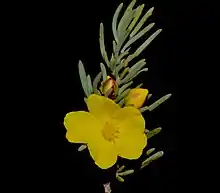| Hibbertia hemignosta | |
|---|---|
 | |
| Scientific classification | |
| Kingdom: | Plantae |
| Clade: | Tracheophytes |
| Clade: | Angiosperms |
| Clade: | Eudicots |
| Order: | Dilleniales |
| Family: | Dilleniaceae |
| Genus: | Hibbertia |
| Species: | H. hemignosta |
| Binomial name | |
| Hibbertia hemignosta | |
| Synonyms[1] | |
|
List
| |
Hibbertia hemignosta is a species of flowering plant in the family Dilleniaceae and is endemic to the south-west of Western Australia. It is a prostrate to erect shrub that typically grows to a height of 30–50 cm (12–20 in).[2] It was first formally described in 1845 by Ernst Gottlieb von Steudel who gave it the name Pleurandra hemignosta in Lehmann's Plantae Preissianae.[3][4] In 2002, Judy Wheeler changed the name to Hibbertia hemignosta in Journal of the Adelaide Botanic Gardens.[5] The specific epithet (hemignosta) means "half-known", but the reason for that name was not given.[6] This hibbertia grows on sandplains, flats and slopes in the Avon Wheatbelt, Coolgardie, Esperance Plains, Jarrah Forest, Mallee, Swan Coastal Plain and Warren biogeographic regions in the south-west of Western Australia.[2]
Hibbertia hemignosta is classified as "not threatened" by the Government of Western Australia Department of Parks and Wildlife.[2]
See also
References
- 1 2 "Hibbertia helianthemoides". Australian Plant Census. Retrieved 22 June 2021.
- 1 2 3 "Hibbertia hemignosta". FloraBase. Western Australian Government Department of Biodiversity, Conservation and Attractions.
- ↑ "Pleurandra hemignosta". APNI. Retrieved 22 June 2021.
- ↑ von Steudel, Ernst G.; Lehmann, Johann G.C. (ed.) (1845). Plantae Preissianae. Hamburg. p. 265. Retrieved 22 June 2021.
{{cite book}}:|first2=has generic name (help) - ↑ "Hibbertia hemignosta". APNI. Retrieved 22 June 2021.
- ↑ Sharr, Francis Aubi; George, Alex (2019). Western Australian Plant Names and Their Meanings (3rd ed.). Kardinya, WA: Four Gables Press. p. 216. ISBN 9780958034180.